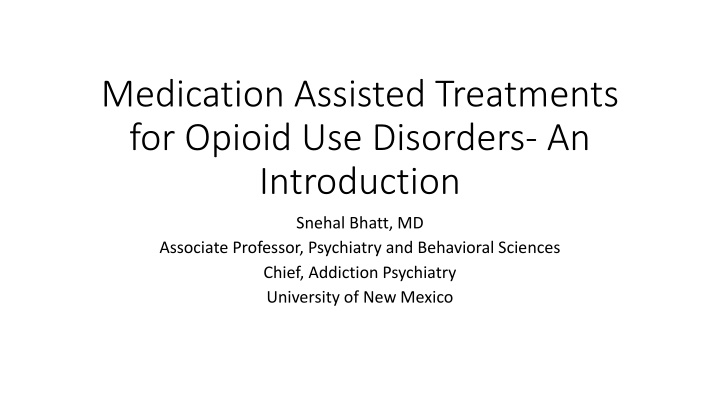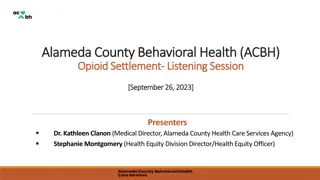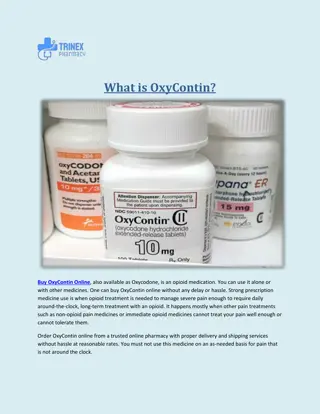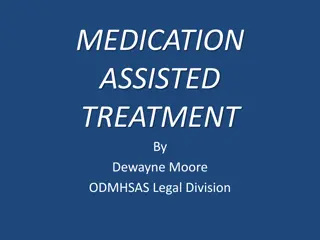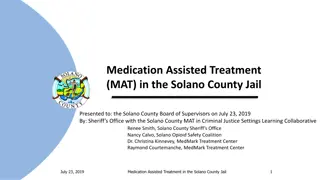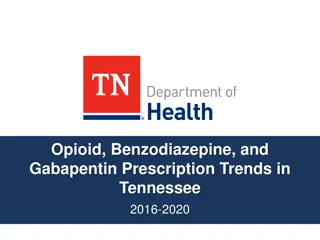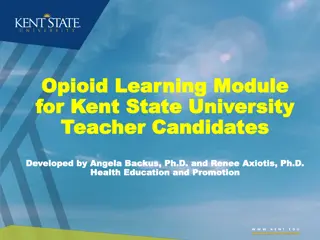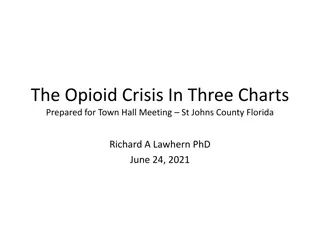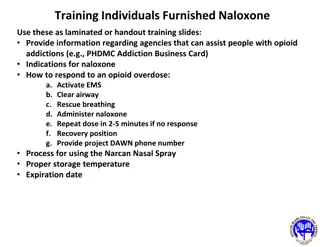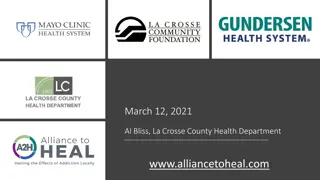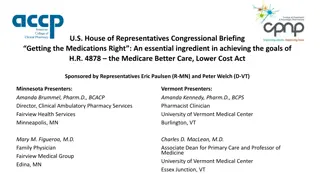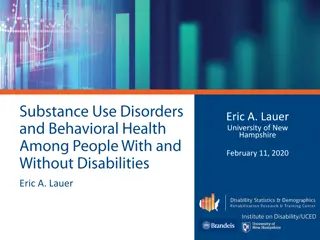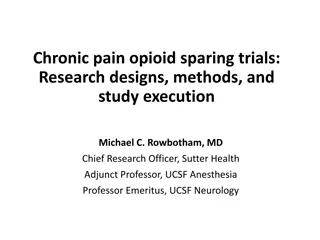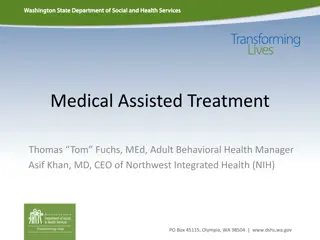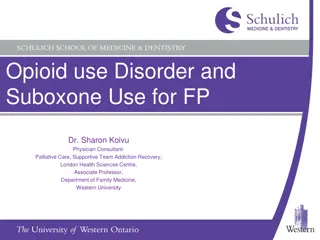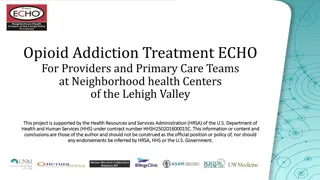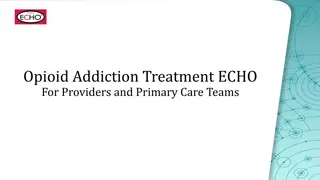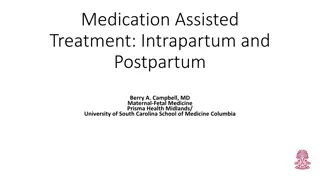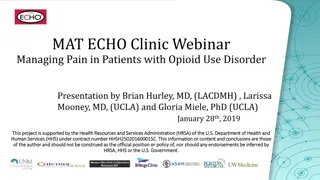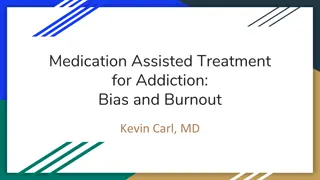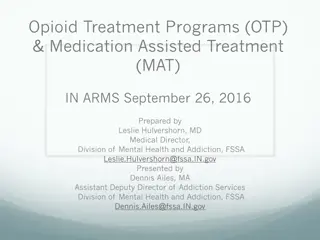Introduction to Medication-Assisted Treatments for Opioid Use Disorders
This presentation delves into Medication-Assisted Treatments for Opioid Use Disorders, highlighting outcomes, FDA-approved medications, and the impact of stigma. It includes a compelling vignette of a 48-year-old male battling opioid addiction and explores adverse outcomes associated with opioid use disorders.
Download Presentation

Please find below an Image/Link to download the presentation.
The content on the website is provided AS IS for your information and personal use only. It may not be sold, licensed, or shared on other websites without obtaining consent from the author.If you encounter any issues during the download, it is possible that the publisher has removed the file from their server.
You are allowed to download the files provided on this website for personal or commercial use, subject to the condition that they are used lawfully. All files are the property of their respective owners.
The content on the website is provided AS IS for your information and personal use only. It may not be sold, licensed, or shared on other websites without obtaining consent from the author.
E N D
Presentation Transcript
Medication Assisted Treatments for Opioid Use Disorders- An Introduction Snehal Bhatt, MD Associate Professor, Psychiatry and Behavioral Sciences Chief, Addiction Psychiatry University of New Mexico
Disclosures No financial disclosures.
Objectives Appreciate the outcomes for treated and untreated opioid use disorders Understand that detoxification alone does not yield acceptable outcomes Become familiar with the three FDA approved medications for treatment of opioid use disorders Understand how stigma and misconceptions can create barriers to effective treatment
Vignette T.S. 48 y/o male; 15 year history of opioid use disorder happily married with two children, well respected in his community, and owned his own construction company before he developed the addiction 16 years ago, he seriously injured his knee, and required surgery; treated with opioids post surgery because he was unable to work consistently due to lingering pain, it led to him losing his construction contracts, ultimately leading to a closure of his business. After this, he experienced worsening depression, along with more generalized pain throughout his body as his mood deteriorated. Continued to receive opioid pain medications through his primary care provider. While he was interested in alternative modalities of treatment, such as physical therapy and acupuncture, these were not available to him locally.
Vignette Within one year of the surgery, required escalating doses of opioid medications to control his withdrawal symptoms. At that point, he began to see multiple providers in a larger city, from whom he received several different prescriptions of opioid pain medications. running out too soon, subsequently experiencing debilitating withdrawal symptoms, and then purchasing illicit opioids off the street. addicted to his pain medications, struggling financially, felt unable to work due to repeated cycles of opioid withdrawals, experiencing more pain that even before, and was concerned that he was no longer active in his community, which diminished his respect as an elder. He also felt shame at having to turn to multiple physicians for his medications.
Adverse Outcomes Associated with Opioid Use Disorders
Adverse Outcomes Infectious diseases Hepatitis C HIV Unemployment Crime Costs to Society Overdoses Mortality
Detox & Drug-free Approach Detox without subsequent medication support Effective for small subgroup: high motivation & stable (Flynn et al., 2003; Van den Brink and Hassen, 2006) Otherwise without medications Up to 90% of detox d pts relapse in first 1-2 mos (Weiss et al., 2011; Smyth et al. 2010) Of those relapse some will die of OD (Kakko et al., 2003)
Similarities with Similarities with Other Chronic Diseases Other Chronic Diseases (Type II Diabetes, HTN, Asthma) (Type II Diabetes, HTN, Asthma) Genetic impact is similar The contributions of environment and personal choice are comparable Medication adherence and relapse rates are similar. Long term maintenance treatments proven most effective. (McLellan, JAMA 2000)
Implications As in all chronic diseases, treatment should be continuous rather than episodic Available treatment leads to substantial improvement in: Reduction of alcohol and drug use Increases in personal health and social functioning Reduction in threats to public health and safety Reduction in monetary costs Therefore, a case must be made to treat addictions like all other chronic illnesses.
A Day in the Life.. Multiple cycles of avoiding, experiencing, and treating withdrawal Insomnia; early morning awakening In withdrawal, or very afraid of it! Continual crisis management I don t use to get high, I use to get well. All resources devoted to answer 1 of 2 questions What do I have to do to not be sick? To keep from becoming sick?
How realistic is it? To expect people to: Use their best judgement Delay gratification Think long term Make a logical / sensible / reasonable decision Could you? Could we??
What the opioid dependent patient feels Dole, Arch Int Med, 1966
Methadone outcomes Heroin use by 50% HIV 4 fold Employment 24% 60% criminal activity Less incarceration Less high risk behaviors More child support payments 3x as likely to remain in treatment Improved hepc treatment adherence Mortality reduced Cost effective Drug users out of methadone treatment 6x more likely to become HIV positive than those in methadone treatment [Metzger et al., 1993]
More benefits of maintenance treatment Decreased IV drug use Decreased needle sharing Decreased cocaine use Decreased unprotected sex Decrease in multiple sex partners Decrease in commercial sex work
Benefits of Pharmacotherapy: Decreased Mortality with Methadone and Buprenorphine [NOT shown with naltrexone] Standardized Mortality Ratio Dupouy et al., 2017 Evans et al., 2015 Sordo et al., 2017
Comprehensive treatment Medication is one part of a more comprehensive treatment Importance of counseling, case management, healthcare Often the hook that leads to treatment engagement Importance of treating underlying illnesses [eg PTSD, hepatitis C] Importance of helping stabilize life [employment, housing] Importance of helping create positive social networks Importance of helping learn coping skills, relapse prevention strategies, emotion regulation
Methadone Schedule II medication Highly regulated Narcotic program treatment settings Full Mu agonist Who is appropriate: At least 1 year of documented opioid dependence Parental consent needed if 16-17 years of age; also need to show at least 3 failed prior detoxification attempts Infectious diseases Pregnant women
Methadone: treatment barriers Out of medical mainstream Stigma of specialized clinics Location of clinics Daily dosing at initiation of treatment Federal regulations
Buprenorphine- Partial agonist 2000: Drug Abuse Treatment Act [DATA] made possible office based prescribing of schedule III opioids 2002: FDA approves long acting sublingual buprenorphine as schedule III opioid Drs required to have 8 hour special training and an X number Upto 30 patients 1st year, then may apply to treat upto 100 patients 2017: CARA: now NPs and PAs can also prescribe with a 24 hour training
Benefits of Office-Based Treatment Private, confidential, and safe treatment provided in a doctor s office Allows for continuity of care with primary physician Does not require daily visits to a clinic or out-of-town, costly residential treatment May allow more patient time for work, family and other activities Improved access About as effective as methadone at reducing opioid use, but less treatment retention
Naltrexone- antagonist treatment Daily oral pill is NOT effective for opioid use disorder Injection long acting naltrexone, given once every 4 weeks, can be an effective strategy Recent studies have show that for many patients, this can be as effective as buprenorphine Harder to initiate [longer wait to first dose] Very expensive No addictive potential
Vignette- Continued outpatient induction onto buprenorphine, and T.S. rapidly stabilized on buprenorphine/naloxone 16/4 mg daily. individual drug counseling, traditional healing Primary care providers were contacted with consent, and other opioid pain medications were discontinued
But isnt it switching from one addiction to another?
Dependence versus addiction Dependence DOES NOT equal addiction Tolerance Same amount of substance insufficient Greater amount to achieve previous effect Withdrawal Characteristic sequelae after discontinuation Typically opposite effects of substance activity Classic examples: alcohol & opioids Atypical example: cannabis Using similar substance to relieve symptoms Tolerance and withdrawals happen with many medications But to have addiction, you also need loss of control, compulsive use, consequences [it effects a person psychologically, socially, spiritually]
Exchanging one drug for another Does it improve outcomes? =YES!!! Allows patients to lead productive lives. Is there dependence? Yes, but recall dependence substance use disorder Was the medication obtained illegally? Doesn t MAT make people high /euphoric? Routinely, No; may be some mild elevation of mood with first dose in pt opioid na ve pt but not thereafter Doesn t MAT promote self-medication? No; like other medications obtained by prescription No; pts are monitored regularly and carefully in accordance with evidence-based practice
Exchanging One Drug for Another Heroin / Illicit Opioids Illegal Avoiding Dope Sick Criminal charges / felony Pharmacologic uncertainty Adulterants / Cutting * Unemployment Getting High or Buzzed Increased criminal behavior IDU / high risk behavior Increased HepC HIV STI Financial ruin Homelessness Familial separation Overdose/death MAT with Methadone/BUP Legal / Prescribed Medical treatment Lawful Known dosages/potency Pharmacologic grade Employment No euphoria Decreased criminal behavior Daily PO/SL medication Decreased Communicable Dzs Financial self-sufficiency Stable housing Familial stability Reduced mortality
How Long Do I Stay in Treatment??
How Long Do I Stay in Treatment?? Continue maintenance as long as patient is benefitting from treatment (opioid/other drug use, employment, educational goals pursued, improvement in relationships, improvement in medical/mental illnesses, engaged in psychosocial treatment) EVERY MAJOR STUDY has shown that treatment retention improves outcomes brief withdrawal periods are unlikely to result in long-term abstinence Worst case scenarios with continuing MAT: $? with stopping MAT: relapse, arrest, jail, OD, death Make list of goals at initiation of treatment and re-assess periodically To give taper the best chance, it should Be initiated when life is stable/goals are met Social networks are different At an individual and gradual pace
Treatment Retention and Buprenorphine Dosage Fiellin et al., 2014
Treatment Retention and Decreased Illicit Opioid Use on MAT Buprenorphine promotes retention, and those who remain in treatment become more likely over time to abstain from other opioids Kakko et al, 2003 Soeffing et al., 2009
A Question of Duration Bear chronic disease model in mind Range of severity Some DM2 do well with lifestyle modification alone Others require 1, 2, 3 or more medications Still others require insulin Likewise with opioid use disorders Some need only brief intervention Others need additional group treatment Some require MAT with injectable naltrexone Others require MAT with buprenorphine or even methadone Some will require indefinite MAT
Diversion Must consider benefits versus side effects for all treatments No one strategy will prevent diversion, but a combination of strategies will help minimize it Strategies to minimize diversion Is the person appropriate for office based treatment? Open discussion of diversion concerns Treatment agreement UDS randomly PMP monitoring Counseling weekly Initial weekly scripts-increase to monthly as patient does well Use a therapeutic dose Random pill counts Enlist aid of pharmacists!! Consider lock boxes Contingency management principles
MAT and Recovery Can you be on MAT and be in Recovery?!
Recovery It is possible, and likely, but we often do not hear of these stories Recovery = sobriety PLUS improved quality of life Reclaiming of the self Abstinence leads to: Improved health and reduced mortality Stable housing Purpose [employment, crime free life] Community engagement; stable fulfilling relationships; sober friends Self-efficacy
Stigma Addictions= THE most stigmatized illnesses Pervasive barrier to accessing care and pursuing recovery Perceived as having moral weakness, character flaws, not trustworthy Medical professionals: views of addictions become increasingly negative as training progresses Recent study: respondents said people with SUDs should receive less priority in healthcare Internalized stigma= worse outcomes Less likely to seek and stay in treatment Worse mental and physical health Decreased employment and housing Poorer support systems Why try effect
Stigma Language matters Addict versus Person with an addiction dirty urine or Positive urine Take a respectful curious, non-judgmental approach
Disparate Treatment SUD s are the only conditions in which: Pt s are expected to improve their conditions before being accepted into treatment Non-compliance / lapse are grounds for dismissal Withholding known life saving treatment considered Known life saving treatment withheld or rationed Active disease considered to be a crime problem Pt s expected to discontinue known effective Rx No/limited insurance coverage for effective treatment
